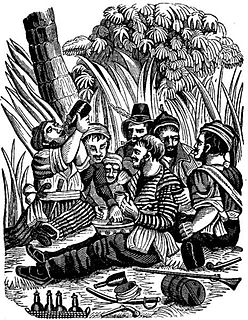Related Research Articles

Bartholomew Roberts, born John Roberts, was a Welsh pirate and the most successful pirate of the Golden Age of Piracy, taking over 400 prizes in his career. Roberts raided ships off the Americas and the West African coast between 1719 and 1722; he is also noted for creating his own Pirate Code, and adopting an early variant of the Skull and Crossbones flag.
Captain Samuel Bellamy, later known as "Black Sam" Bellamy, was an English sailor, turned pirate, who operated in the early 18th century. He is best known as the wealthiest pirate in recorded history, and one of the faces of the Golden Age of Piracy. Though his known career as a pirate captain lasted little more than a year, he and his crew captured at least 53 ships. Called "Black Sam" in Cape Cod folklore because he eschewed the fashionable powdered wig in favor of tying back his long black hair with a simple band, Bellamy became known for his mercy and generosity toward those he captured on his raids. This reputation earned him another nickname, the "Prince of Pirates". He likened himself to Robin Hood, with his crew calling themselves "Robin Hood's Men".
John Taylor was a pirate active in the Indian Ocean, best known for participating in two of the richest pirate captures of all time.

Thomas Anstis was an early 18th-century pirate, who served under Captain Howell Davis and Captain Bartholomew Roberts, before setting up on his own account, raiding shipping on the eastern coast of the American colonies and in the Caribbean during what is often referred to as the "Golden Age of Piracy".
Jeremiah Cocklyn, better known by the name Thomas Cocklyn, was an English pirate known primarily for his association with Howell Davis, Olivier Levasseur, Richard Taylor, and William Moody.
See also 1720 in piracy, other events in 1721, 1722 in piracy and Timeline of piracy.

John Phillips was an English pirate captain. He started his piratical career in 1721 under Thomas Anstis, and stole his own pirate vessel in 1723. He died in a surprise attack by his own prisoners. He is noted for the articles of his ship, the Revenge, one of only a few complete sets of pirate articles to survive from the so-called Golden Age of Piracy.

The Capture of the schooner Fancy was a famous British victory over two pirate ships under Captain Edward Low. When off Delaware Bay Low attacked a Royal Navy man-of-war which he mistook for a whaler. The resulting combat lasted several hours and ended with the capture of one pirate vessel. In fact, the captured vessel was not the one named Fancy - factually, the combat should have been called "Capture of the sloop Ranger."

The Battle of Cape Lopez was fought in early 1722 during the Golden Age of Piracy. A Royal Navy man-of-war under Captain Chaloner Ogle defeated the pirate ship of Bartholomew Roberts off the coast of Gabon, West Africa.

Joseph Bannister was an English pirate who operated in the Caribbean during the Golden Age of Piracy. He is best known for defeating two Royal Navy warships in battle.
Christopher Winter was an English pirate active in the Caribbean. He is best known for sailing in Spanish service and launching the career of Edward England.
John Ireland was a pirate active in the Indian Ocean. He is best known for sailing with Thomas Tew.
Montigny La Palisse was a French pirate best known for his association with Bartholomew Roberts.
Brigstock Weaver was an English pirate active in the Caribbean. He is best known for his association with fellow pirates Thomas Anstis and Bartholomew Roberts.
William Read was a pirate active in the Indian Ocean near Madagascar. He is best known for rescuing fellow pirate captains John Bowen and Thomas White.
Robert Sample was a pirate active off the coast of Africa and in the Caribbean. He is best known for sailing with Edward England.
Paulsgrave Williams, first name occasionally Paul, Palsgrave, or Palgrave, was a pirate who was active 1716–1723 and sailed in the Caribbean, American eastern seaboard, and off West Africa. He is best known for sailing alongside Samuel Bellamy.
John Cornelius was an Irish pirate supposedly active in the Red Sea and off the west coast of Africa. He succeeded William Lewis, who was killed after announcing he'd made a pact with the Devil. Lewis and Cornelius are likely the fictional creations of Captain Charles Johnson, who presented their stories among those of real historical pirates.
David Williams was a Welsh sailor who turned pirate after being abandoned on Madagascar. He was only briefly a Captain, and is best known for sailing under a number of more prominent pirate captains.
John Pro was a Dutch pirate best known for leading a pirate trading post near Madagascar.
References
- ↑ Stapleton, David (2001). "Thomas Anstis". Pirate Roster. PiratesHold.com. Archived from the original on 4 February 2012. Retrieved 25 February 2012.
- ↑ Some accounts have Anstis keeping Morning Star and granting his own ship Good Fortune to Brigstock Weaver; and according to Henry Treehill, who testified at Brigstock Weaver's trial, John Fenn was elected captain of the Antelope after Anstis' crew committed mutiny following the loss of the Morning Star. See: Gosse, Philip (1924). The Pirates' Who's Who by Philip Gosse. New York: Burt Franklin. Retrieved 23 June 2017.
